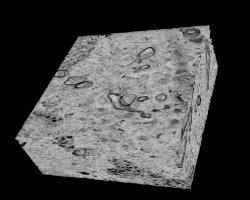Mar 4 2010
Literally adding a new dimension to the appreciation of anatomical research, Norway’s projectiondesign has supplied its F10 AS3D active stereo 3D DLP® projector to present the work connected with the worldwide Blue Brain Project (BBP).
 The projectiondesign F10 AS3D reproduces a 3D reconstruction of brain tissue suffering from Alzheimer’s Disease
The projectiondesign F10 AS3D reproduces a 3D reconstruction of brain tissue suffering from Alzheimer’s Disease
The presentation was given earlier this year by the Universidad Politecnica de Madrid (UPM) in Spain to promote its new BioTech initiative, which is based at the university’s Montegancedo campus and which, among other things, will integrate the university’s work on the BBP with that of other Spanish institutions, notably the Instituto Cajal of the Consejo Superior de Investigaciones Cientificas.
In order to communicate the UPM’s role in advancing the Blue Brain Project, a 3D presentation was given showing a series of 3D images including a single neuron, cortical column activity, and a cross-section of the brain of a mouse diagnosed with Alzheimer’s disease.
Jose Maria Peña, Project Director takes up the story: “The Blue Brain Project is the first comprehensive attempt to reverse-engineer the mammalian brain, in order to understand brain function and dysfunction through detailed simulations. The UPM and the Instituto Cajal are both playing important roles in the Project, and 120 high-profile researchers attended the presentation – mainly representatives of medical research centres, hospitals, and the BioTech initiative’s industrial and technological sponsors.”
“The F10 AS3D was used in conjunction with a 3-metre wide screen for the 3D presentation where the audience used active-stereo 3D glasses to view the presentation with an extremely positive response.”
Mercedes Sainz, Sales Manager Spain & Portugal at projectiondesign, adds, “Perfectly tailored for use in scientific visualisation and simulation, projectiondesign’s F10 AS3D is the market’s only available full, high resolution projector that enables active 3D stereoscopic visualisation from an extremely compact, and easy to set up unit. It has since its launch been widely acclaimed for its ability to make 3D stereoscopic presentations easier and more approachable for users and audiences alike, while retaining the detail required for high end visualisation and medical imaging.”